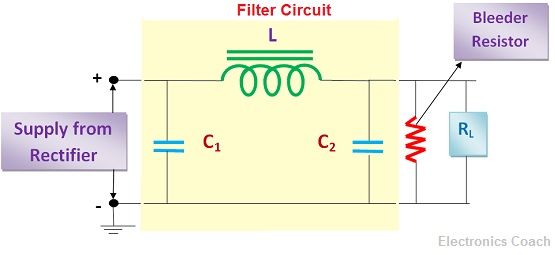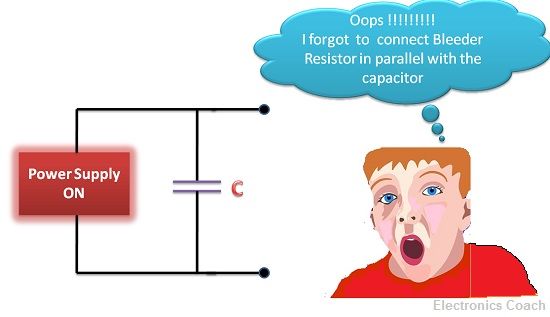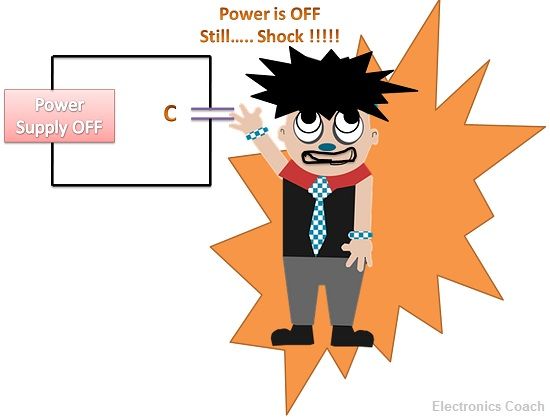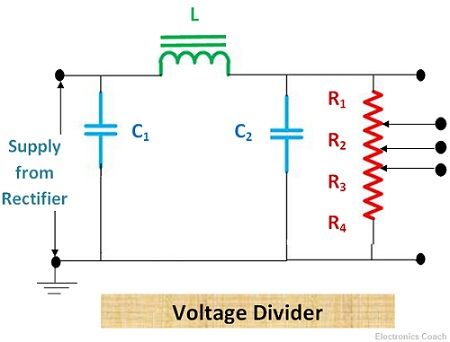Definition: Bleeder Resistor is a standard resistor which is connected in parallel with the capacitor of the filter circuit to provide discharging of the capacitor. If the capacitor is not discharged properly, then it may lead to an electric shock to the person operating it.
Thus, to ensure the safety of the operators working with it, it is necessary to connect a resistor in parallel with the capacitor.
Significance of Bleeder Resistor
To understand the significance of bleeder resistor, let’s consider a circuit. In this circuit power supply is given by the rectifier or the output of the rectifier is connected to the input of this experimental circuit.

Now, the input to this circuit is given by rectifier, and the output of the rectifier is pulsating DC. Thus, we need to use filter circuit also. In a filter circuit, we have inductor and capacitor.
When the power supply is “ON” the capacitor starts charging. And do remember one crucial thing; we need to connect a standard resistor in parallel with the capacitor, i.e. bleeder resistor. What if we forget to connect the resistor?

If you have not connected the bleeder resistor in parallel with the capacitor of the filter circuit, it may give an electric shock to the operator working with it.
Strange!!!! Why I experienced electric shock? I have touched the capacitor when the power was OFF but still this electric shock??

You must be thinking that what is the reason behind this electric shock? Let me explain. When the power was switched ON, the capacitor gets charges to its peak value. After switching OFF the power supply, the capacitor is still charged, because it consists of the previous charge. If we touch this capacitor, we will experience electric shock irrespective of the OFF power supply.
Therefore, we need a resistor, so that the capacitor can discharge properly after switching OFF the power supply. Thus, a resistor of standard value is connected in parallel with the capacitor, which helps in discharging after the curtailment of power.
Functions of Bleeder Resistor
Effective Voltage Regulation
Bleeder resistor helps to achieve better and improved voltage regulation. Voltage regulation is the ratio of the difference between no-load voltage and full load voltage to the full load voltage in the denominator.
If the difference between no-load voltage and full load voltage will decimate, then the voltage regulation will be improved. The bleeder resistor is connected in parallel with both the capacitor of the filter circuit as well as the load resistor.
Thus, there will be two voltage drop, one across the bleeder resistor and one across the load resistor. In the absence of load resistor, the no-load voltage drop will be equal to the voltage drop across bleeder resistor.
Thus, when no load is connected then also there is some voltage drop. And after connection of the load, the voltage drop across the load will be taken into consideration. In previous cases, the voltage regulation without bleeder resistor is poor because the difference between no-load voltage and full load voltage is high.
In case of bleeder resistor connected in the circuit, the difference between the no-load and full load voltage is very less. Consequently, this leads to improved voltage regulation.
Safety Purpose
Bleeder resistor proves to be a component which saves us from hazardous repercussions. Anyone working with the circuits may get electric shocks in the absence of bleeder resistor.
Thus, it is a crucial device for protection from electric shocks.
Voltage Divider
This adds to one of the significant advantages of bleeder resistor that it can be used as a voltage divider. If we require a device to provide two or three voltage supply, then tapping can be done, and bleeder resistor will act as 2, 3 or 4 resistors connected in series.

In this way, it also provides the functioning of the voltage divider.
In this article, we have discussed bleeder resistor which is certainly a vital electronic component in electronic circuits. To design a circuit, it is necessary to have a detailed knowledge about such component which indirectly plays a significant role in circuit processing.
Moreover, its multiple functions make this electronic component worth. The elementary step for understanding electronics, designing electronic circuits or simulating or synthesizing the circuit, is to have the knowledge about components that do not involve the direct role in the process of the circuit but still without these components a circuit cannot work efficiently.
Pankhuri Saxena says
Nice content and lucidly explained 👍👍👌👌
Krati P says
Thanks for the appreciation !!
Bruno B. says
It’s the first thing to consider, always, for AC and DC capacitors and time of discharge to a safety level too .
Eugene says
Thank you ! Helped me to understand E7D14 question of ARRL Extra class license exam. (bleeder resistor improves voltage regulation)
naresh says
thank you
Electron89 says
Presentation is very ingenious .
Thanks